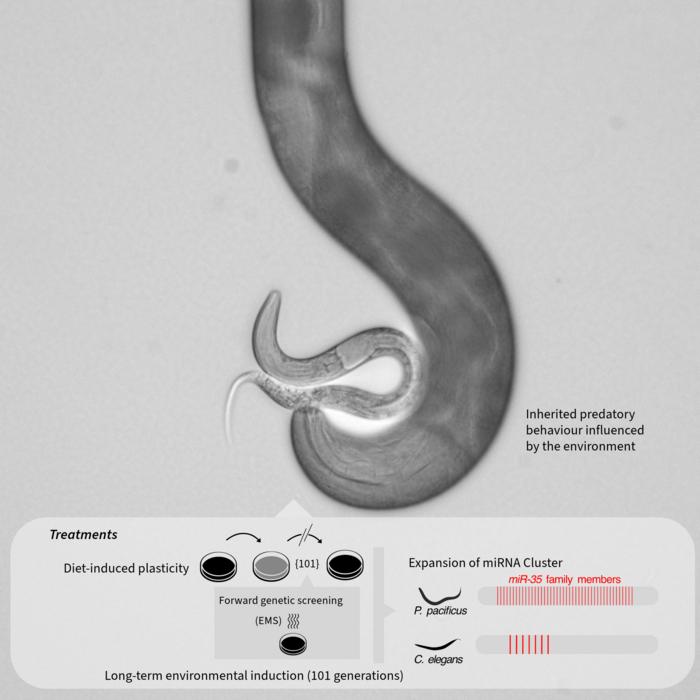
In a remarkable study published in the esteemed journal Science Advances, researchers from the Max Planck Institute for Biology in Tübingen have unveiled groundbreaking insights into the evolutionary adaptability of nematodes. Over the course of 101 generations, these organisms demonstrated an extraordinary capacity to shift their behavior from a standard diet to an exclusively predatory lifestyle, a transition that profoundly questions conventional beliefs regarding genetic predisposition in evolutionary biology.
The research, under the direction of Dr. Ralf Sommer, emphasizes the deep connection between environmental influences and behavioral traits. By exposing nematodes to a novel food source derived from the bacteria Novosphingobium instead of their usual E. coli diet, the researchers witnessed a complete and immediate shift towards a 100% predatory behavior across all tested lines. This pivotal finding suggests that behavior in nematodes is not fixed by genetic determinants but is, instead, a dynamic quality influenced significantly by environmental changes.
What is particularly fascinating about this study is the emphasis on multi-generational adaptation. During their extensive research, the team discovered that it requires an exposure period of up to five consecutive generations to establish a lasting behavioral shift towards predation. This novel insight opens up new avenues for understanding behavioral evolution, suggesting that the interplay between generational exposure and environmental factors is more profound than previously acknowledged.
Moreover, the role of microRNAs was highlighted as a critical component in these adaptations. Specific microRNAs from the miR-35 family were identified as pivotal to this transgenerational inheritance linked to the EBAX-1 gene. Such findings could lead to significant advancements in genetic research, particularly in understanding how environmental factors can induce rapid evolutionary changes in living organisms.
Dr. Sommer elaborated on the implications of their research, asserting that it paves the way for a new understanding of behavioral plasticity. His assertion reflects a shift in thinking about how species adapt over longer evolutionary timeframes and how these changes may occur much faster than scientifically assumed. This adaptability, motivated by immediate ecological changes, challenges the traditional view of evolutionary processes as gradual and highlights the urgency with which organisms can respond to their environments.
In this context, the research compels the scientific community to reassess the principles of phenotypic plasticity, reevaluating the balance between genetic inheritance and environmental factors. Dr. Sommer’s insights underline that long-term environmental exposure can induce significant changes in both behavior and gene expression over time. This research contributes to a broader understanding of biology, revealing intricate connections between ecology, genetic memory, and evolutionary mechanisms.
Furthermore, the research team plans to conduct follow-up studies aimed at illuminating the specific molecular targets of microRNAs and the operational pathways activated by the different dietary agents involved. The complexity surrounding these genetic mechanisms holds promise for future investigations into not just nematodes but potentially other species exhibiting similar behavioral adaptability.
The research also prompts important considerations regarding ecological and evolutionary relationships in changing environments, especially as global conditions continue to fluctuate. The adaptive strategies employed by nematodes showcase a testament to resilience in the face of environmental stressors, suggesting that similar mechanisms may exist in other organisms.
Another pertinent aspect raised by this study is the need for a comprehensive understanding of evolutionary dynamics, integrating more ecological perspectives into evolutionary theory. As evidenced by this research, the crosstalk between environment and evolutionary development holds significant implications for how we interpret adaptation and survival strategies in many species. These insights could be transformative, informing conservation efforts and strategies as ecosystems continue to evolve in response to human-induced changes.
In summary, the study from the Max Planck Institute not only illustrates the remarkable adaptability of nematodes but also lays the groundwork for new paradigms in evolutionary biology. The significant conclusions drawn regarding predatory behavior and genetic memory underscore the dynamic nature of life and its capacity to evolve rapidly under varying circumstances. As the researchers continue their endeavors, biology stands on the precipice of a deeper, more nuanced understanding of how species respond and adapt to their environments at both behavioral and molecular levels.
Subject of Research: Adaptation of nematodes to predatory behavior through environmental changes
Article Title: EBAX-1/ZSWIM8 destabilizes miRNAs, resulting in transgenerational inheritance of a predatory trait.
News Publication Date: 12-Mar-2025
Web References: http://dx.doi.org/10.1126/sciadv.adu0875
References: Science Advances
Image Credits: MPI f. Biology Tübingen/ Image adapted from Ata Kalirad
Keywords: nematodes, predatory behavior, environmental adaptation, genetic memory, microRNA, evolutionary biology, phenotypic plasticity
Tags: behavioral evolution across generationsbehavioral traits influenced by environmentdietary shifts in nematodesenvironmental influences on behaviorevolutionary biology research findingsgenetic predisposition in evolutioninherited predatory behavior in nematodesMax Planck Institute nematode studymulti-generational adaptation in nematodesnematodes as model organismsNovosphingobium as food sourcepredatory lifestyle in nematodes




